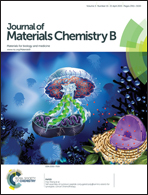Sensing cell adhesion using polydiacetylene-containing peptide amphiphile fibres†
Abstract
Sensing cell adhesion by means of a colourimetric response provides an intuitive measure of cell binding. In this study polydiacetylene-containing peptide amphiphiles fibres were designed to sense cell adhesion by means of a colour change. The diacetylene-containing peptide amphiphiles were functionalised with the cell-binding motif RGDS, and subsequently mixed with non-functionalised diacetylene-containing spacer amphiphiles. The diacetylenes in the backbone of these fibres were polymerised using UV-light to give dark blue fibre solutions. Subsequent cell adhesion induced a colour change from blue to pink. The propensity of the RGDS fibres to change colour upon cell adhesion could be tuned by varying the C-terminal amino acid of the spacer amphiphile. In addition to this, by varying the RGDS density we found that the optimum colourimetric response was obtained for fibres with a 6 : 1 ratio of non-RGDS to RGDS amphiphiles.


 Please wait while we load your content...
Please wait while we load your content...